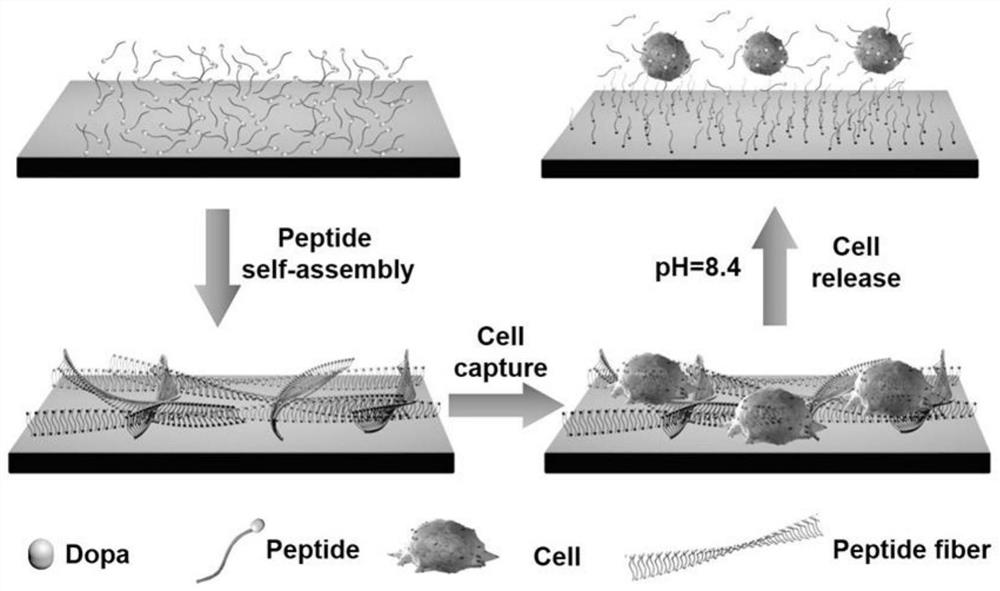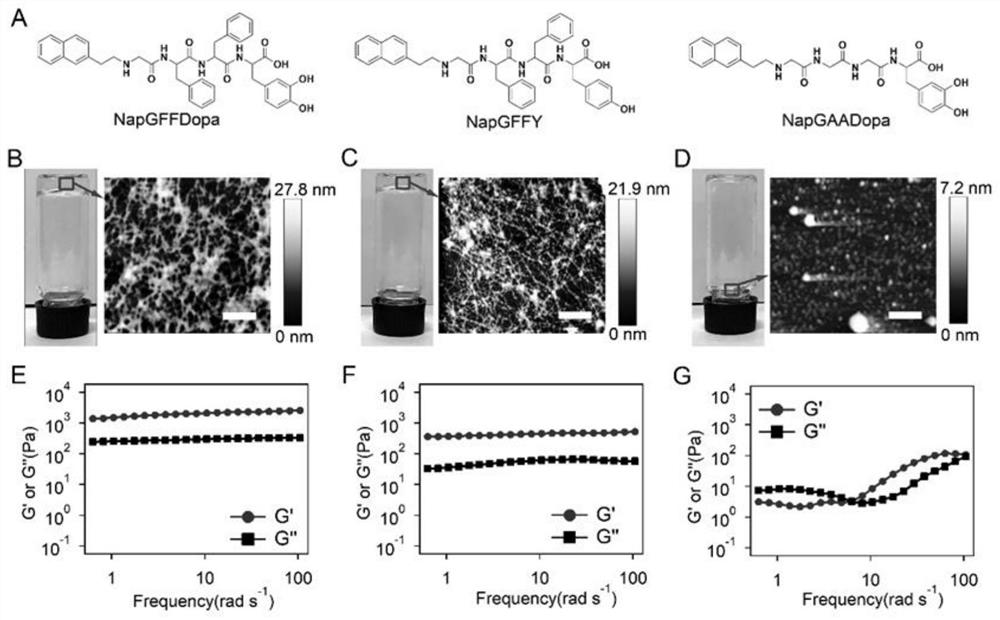Novel bionic adhesive material, and preparation method and application thereof
An adhesive material and a new type of technology, applied in the preparation method of peptides, chemical instruments and methods, preparation of animal glue or gelatin, etc., can solve problems such as uncontrollable, limited application, weak adhesion strength, etc., to ensure consistency , improve work efficiency, and take effect quickly
- Summary
- Abstract
- Description
- Claims
- Application Information
AI Technical Summary
Problems solved by technology
Method used
Image
Examples
preparation example Construction
[0031] A preparation method of a novel bionic adhesive material, the steps are as follows:
[0032] S1. Modification and protection of dopa molecule: firstly, in anhydrous CH 3 Add dihydroxyphenylalanine (Dopa) (2.0g, 10.1mmol) and TBDMS-Cl (4.6g, 30.5mmol) to CN (23.0mL); cool with ice-water bath for 10min, then add dropwise DBU (4.6mL, 30.2 mmol) more than 10min; after that, allow the reaction mixture to be ice-bathed for 4h, then react at room temperature for 20h; : Dichloromethane (from 1:9 gradually increased to 3:7) mixed solution is eluted to remove impurities, and the eluent is rotary evaporated to remove solvent to obtain white product Dopa (TBDMS) 2 -OH; Dopa (TBDMS) 2 -OH (8.62g, 31.3mmol) and 40mL 10% Na 2 CO 3 The solution was added to 113mL THF, and this process was carried out in an ice bath; FmocOSu (6.39g, 19.0mmol) was added after the mixture was stirred and reacted for 10 minutes, and after stirring and reacting for 4h under ice bath, the reaction was co...
Embodiment 1
[0039] Example 1 Morphological and mechanical characterization of the invention.
[0040] In the experiment, we used another two groups of peptide samples as controls to verify the principle of the excellent adhesion performance of 2-NapGFFDopa. 2-NapGFFY without dopa and 2-NapGAADopa containing dopa but unable to self-assemble, respectively, such as figure 2 As shown in A. Usually, the solid hydrogel can be obtained by quickly adding the polypeptide solution (DMSO dissolved) containing 2-NapGFFDopa or 2-NapGFFY into phosphate buffered saline (PBS, pH=7.4), and shaking and mixing evenly. product. However, 2-NapGAADopa is still in a liquid state because it cannot self-assemble to form a fiber network. It can also be seen from the atomic force microscope (AFM) scan that there are very obvious fiber network structures in the 2-NapGFFDopa and 2-NapGFFY samples, such as figure 2 Shown in B~D. Utilize the mechanical test that rheometer carries out also can find out, the stora...
Embodiment 2
[0041] Example 2 Test of the present invention on pH-responsive disassembly.
[0042] For pH-responsive disassembly, we use NaHCO 3 solution to adjust the pH range. Experiments showed that when the pH of the environment was adjusted from 7.4 to 8.4, the 2-NapGFFDopa hydrogel gradually changed from a solid state to a liquid state within 30 minutes, and the AFM scan also verified the disappearance of the fiber network structure. like image 3 As shown in A. The circular dichroism experiment also verified this point. The circular dichroism (CD) of the assembled 2-NapGFFDopa showed an obvious peak corresponding to the beta sheet structure at 215nm, while no obvious peak was observed in the decomposed peptide solution. signal, which is consistent with the AFM imaging results ( image 3 B). Rheological experiments showed that the storage modulus of 2-NapGFFDopa also began to be smaller than the loss modulus after the pH increase treatment, which also proved the fluidization of ...
PUM
 Login to View More
Login to View More Abstract
Description
Claims
Application Information
 Login to View More
Login to View More - R&D
- Intellectual Property
- Life Sciences
- Materials
- Tech Scout
- Unparalleled Data Quality
- Higher Quality Content
- 60% Fewer Hallucinations
Browse by: Latest US Patents, China's latest patents, Technical Efficacy Thesaurus, Application Domain, Technology Topic, Popular Technical Reports.
© 2025 PatSnap. All rights reserved.Legal|Privacy policy|Modern Slavery Act Transparency Statement|Sitemap|About US| Contact US: help@patsnap.com



